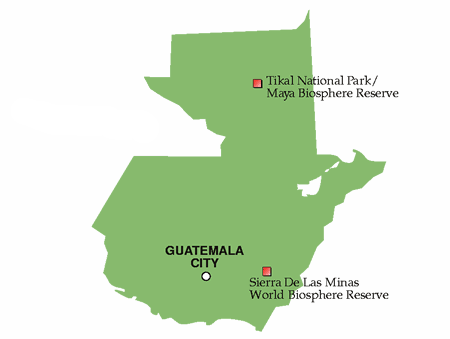Guatemala
“Glittering emerald-feathered magnificent quetzals keep an eye out for crested harpy eagles in Sierra de las Minas, largest contiguous cloud forest in Central America. But harpies would rather carry off a real feast, a monkey or slow-moving sloth.”
Stealthy jaguars and ocelots are protected here along with lumbering Baird’s tapirs and arboreal howler and spider monkeys in one of the highest percentages of conservation land set side by any Latin American country.Reserves include portions of mountains, forest highlands, jungle plains, and much of Central America’s largest rain forest.
It is enough undisturbed land—42,000 square miles (109,000 km2), covering 19 different ecosystems—to furnish a reservoir for plants and animals now threatened over most of Central America, as well as for 45 among 1,500 vertebrate species that exist nowhere else.
ome 250-odd kinds of mammals roam free here, including tawny nocturnal kinkajous, related to raccoons but swinging through trees like monkeys. Mexican anteaters slurp up stinging ants (anteaters are conservationists, not destroying ant colonies but only grazing to return another day). Reptiles and amphibians of 200 species include two crocodiles and endangered leatherback, olive ridley, and Tortuga negra sea turtles.
Huge-billed toucans, screaming scarlet macaws, tiny iridescent hummingbirds, and great fierce raptors, including formidable harpy eagles, are among 664 kinds of birds. Streamer-tailed magnificent or resplendent quetzals, birds for which the Guatemalan monetary unit is named, are here. (Ancient Mayan law carried a death penalty for their unauthorized killing.) Gleaming peacock-like ocellated turkeys gobble and strut, and in watered areas, graceful herons, waterfowl, and dozens of migratory species forage for insects and minnows.
More than 8,000 plant species are protected—600 kinds of orchid alone, including Guatemala’s national flower, the exquisite white nun.
Largest set-aside is 8,125-square-mile (21,050-km2) MAYA BIOSPHERE RESERVE covering the northern third of the Peten region, comprised of seven parks or reserves encircled by a buffer zone where environmentally-compatible human activities are permitted. Among the parks is 222- square-mile (576-km2) TIKAL NATIONAL PARK which has, as well, major Mayan archeological sites. SIERRA DE LAS MINAS BIOSPHERE RESERVE is Central America’s most important cloud forest reserve.
Designating such places does not ensure protection. Funds are short to control poaching, squatters, and slash-and-burn farming and logging. This is a problem, as is recurring political unrest. A consular information sheet says no area is “always safe,” particularly for private vehicles after dark. Travelers should enquire about recent activities and best ways to visit a destination before setting out.
A promising regional conservation approach would have neighboring countries work in concert to protect large contiguous areas—as in Mexico’s CALAKMUL BIOSPHERE RESERVE in southern Yucatan (see p.451), adjoining Guatemala’s MAYA BIOSPHERE RESERVE and, in next-door Belize, RIO BRAVO CONSERVATION AREA (see p.334) and AGUAS TURBIAS NATIONAL PARK. Cooperative ecotourism could help protect this entire region while bringing income to national economies and make natural systems worth more to their people.
More about the Reserves in Guatemala
Each button selection will take you to a site outside the Nature's Strongholds site, in a separate window so that you may easily return to the reserve page.
Advertisement




